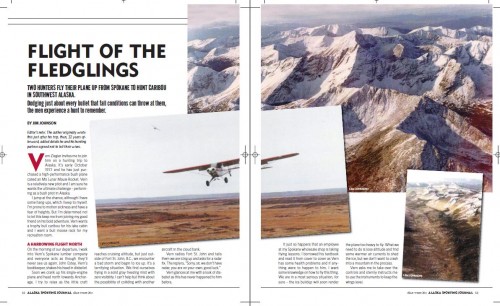
They Have A Love Affair With Alaska Fishing
The following appears in the June issue of Alaska Sporting Journal:
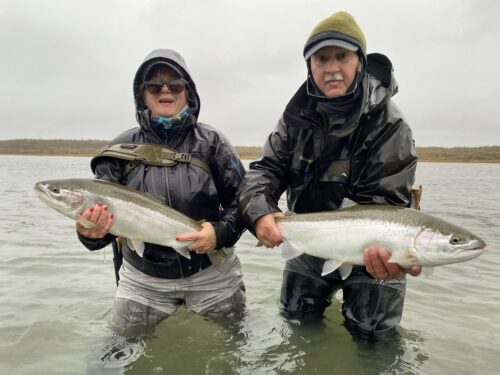
Dave Agness and his wife Lindsay are constantly leaving their home in Rochester, New York, to fish around the world (think the Seychelles Islands off the east coast of Africa, Central America’s Belize, and Canada). But in the couple’s 2019 debut book, Fishing Adventures on the Fly with Dave and Lindsay Agness, they devoted three chapters to their angler experiences in the Last Frontier. And Dave Agness captured why in one simple declaration.
“I said this in my first book: ‘I know there’s never going to be a McDonald’s or a Burger King or an apartment building in any direction in which I am looking,’” he says. “That’s how wild it is.”
In this second edition of the book, the Agnesses decided to put some of their knowledge of fly fishing techniques into how-to sections. But mostly, Dave and Lindsay are sharing adventures everywhere from their home in the Northeastern U.S. to exotic locations around the globe and, of course, one of their favorite destinations, Alaska (just one chapter covers their most recent adventure in the 49th state, where even with the salmon runs completed, the rainbows, grayling and especially pumpkin-colored Arctic char were biting like mad demons).
“We immediately fell in love with the place, and that’s why we’ve been going back there for the last 20 years,” Dave notes.
The following is excerpted with permission from Fishing Adventures on The Fly Techniques and Tactics, by Dave Agness, and is published by Palmetto Publishing.
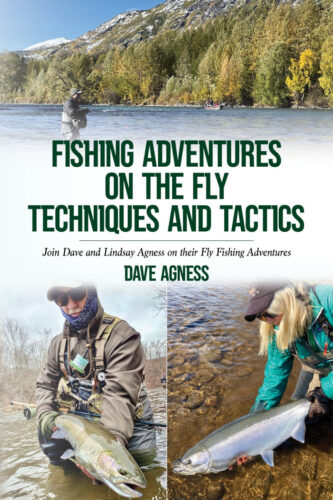
BY DAVE AGNESS
Justin guided the sled to a tiny island in the middle of the run. Downstream was a bigger island where the Naknek River raced around both sides. This was the same spot our guide Gray had pleaded with me the day before to make a last stand at the end of a long day.
I did get out of the boat and swung this spot, and after countless casts to which I had a couple half-hearted pulls from a fish, we called it a day. Yesterday had been sunny but very cold in the morning, and the water temps were frigid, slowing down the grabbiness of the migratory rainbows. My wife Lindsay had scored a nice fish, but I wasn’t as fortunate. It was impossible to pass on Gray’s excitement for this last stand, though, so I had obliged and cast-stepped down the run, with a big zero finding a player. Gray, who is as passionate as any guide
I’ve ever fished with, was still in shock at dinner Wednesday night about our slow day. I bought him a few cocktails to ease his pain.
So here we were again. Same run, steady rain soon turning to snow. Justin gave us a lay of the land, explaining the series of slots that ran to the big island. Where we stood in ankle-deep pea gravel, further out there were dips and slots in the gravel where these Naknek ’bows would ambush their prey.
Still, after yesterday’s “no-hitter,” I was a bit skeptical. I got to be the lead down the run (likely because I was fishless the day before), with Linds 20 yards behind me. She was fishing a patented flesh fly and I had the staple black and white Dolly Lama knotted to my tippet.
There was one element that was different this time. With the rain system rolling into King Salmon, Alaska, and instead of a clear night and temps down into the teens like the day before, it was mid-40s with a warm rain.
Probably about six casts in, a fish came to the fly with commitment rather than the plucky teases of the day before, and I was locked up on a screaming fish. Just as I turned to look back at Lindsay because I knew she’d be excited to see me hooked up, her rod was also bent double with her own player (of course) and we had our famous “Agness Double.” We both coaxed our fish over to the boat, where Justin deftly netted the pair and our day, while only just beginning, was also already a huge success.
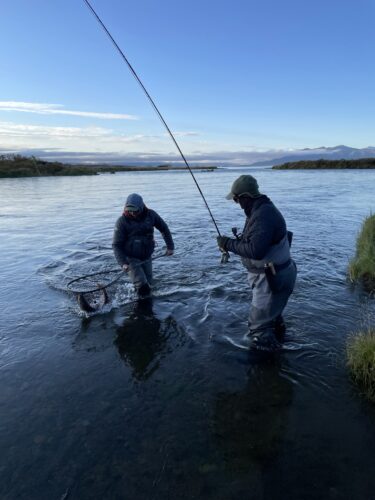
IN 2019, LINDSAY WENT to King Salmon with some girlfriends on a fishing trip. I was on our annual trip to (New York’s) Long Island Sound off Watch Hill with a couple buddies. She would text me a picture or two of rainbows and steelhead she was swinging up with her two- hander, but when I picked her up at the airport, she showed me a picture that sealed the deal. A double-digit – weight- wise – pumpkin-colored Arctic char.
We weren’t out of the parking lot at the airport before I said, “We are going back!” I called outfitter owners Kate and Justin Crump of Frigate Travel (frigatetravel.com; thelodgeat58north.com) and picked out a late-September/early-October 2020 return. The timing was all planned around getting after those char, with the bonus of dime-bright Naknek migratory rainbows on the bill; swinging streamers is, of course, our forte.
Then the world was blindsided by Covid-19, and our 2020 trip was put on hold until 2021. It’s agonizing to be put on hold. I usually start planning on a big trip many months before departure by gathering the gear we’ll need, and start to tie flies, but as March 2020 rolled in, the world was in a state of shock and awe as something was happening that hadn’t happened in over 100 years – a pandemic, with science caught off guard and people dying by the tens of thousands worldwide every day.
Pandemic air travel is not necessarily difficult, but it is antagonizing. We had the quick hop from Rochester to Chicago, a short layover and then the six-and-a- half-hour ride to Ted Stevens Airport in Anchorage, with masks on. That wasn’t exactly relaxing. I hadn’t flown anywhere since pre-pandemic 2019, so things had changed. In-flight movies were now streamed to your phone or iPad. Since we don’t have or carry an iPad, I watched a couple movies on my phone, and that wasn’t nearly as enjoyable, but hey, it’s the price you have to pay to travel to fish these days.
We had a day-and-a-half layover in Anchorage before flying to Bristol Bay, so we rented a car to run down to the Kenai Peninsula, which we’ve fished on our own many times in the past. After picking up the truck, as is tradition when we get to Anchorage we drove to our favorite gin mill in a strip mall called the Blue Fox, and settled in with the natives for a couple ice-cold Alaskan Ambers.

ON SUNDAY MORNING, UNDER a foggy, cloudy sky, we headed out after a hearty breakfast. As mentioned in past stories, the ride down through Turnagain Arm on the Sterling Highway is a day adventure in and of itself. We pulled over to watch beluga whales hunting along the shallow bars at low tide. Eagles soared overhead, against a snow-capped mountain range.
What we hadn’t planned for was the 4 inches of snow in the area two days before, with morning temps hovering just under freezing. As we crossed the first bridge over a small river, the SUV started sliding sideways, and as I got control we realized that as we climbed up into the mountains the roadway and bridges would be pure ice. I pulled over and locked the truck into four-by-four and proceeded cautiously.
The ride going only half- to three- quarters the speed limit took us an extra 45 minutes to an hour, but we finally arrived at our first spot, Ptarmigan Creek. The creek was low, but a more important factor was the sockeye salmon run was over, and only a few old zombies remained. We geared up, but after fishing for less than a half hour, knew the rainbows and char that would otherwise be congregating behind the salmon had moved on up to the lake for the winter.
Our next play was to run down to the Russian River, where we expected the same fate of the sockeye run, but there is a manmade walkway all the way down to the confluence of the Russian and Kenai Rivers. Now, we’ve had a few encounters with brown bears along the Russian, and if the salmon were gone, the bears would be turning to berries and other forms of nutrition. Not that I think bears intentionally seek to eat human flesh; I think they attack to maul simply because we are a nuisance and in their way.
We stopped at the Troutfitters fly shop to pick up a couple things. I asked the guy handling the counter how the bears were along the Russian, and he simply said, “They’re there!” He happened to have a spare can of bear spray and loaned it to me. I promised to bring it back before closing, and in my thoughts I hoped that would be the case.
We geared up in the lowest parking lot, “Grayling,” and jumped on the metal walkway down to the Kenai. Halfway down, sure enough, there was a pile of fresh bear scat loaded with berries on the walkway. We had been “hey bear”-ing all the way down and stopped to scan the area to make sure Mr. Bear had moved on, and found our way to the main river.
The Kenai runs pretty strong, but we found good footing and in a short while each of us hooked a couple leopard ’bows. There was a sizable island just below us, with a hard frothy run that slowed to a beautiful tailout below. Lindsay waded over and climbed up on the island. I did as well and we found a small path to the front of the island. We stopped to get our bearings and I noticed we were in a giant berry patch. In 10 more steps we came across a huge fresh pile of scat covered in berries. The tailout was 50 yards through thick brush on a game trail – meaning a bear trail. I said, ”OK, we are out of here.”
There were no sockeye for the bears to eat – only berries – and we were standing in the middle of the berry grocery store. Time to move; and we did, retreating to the previous spot. Shortly after, we broke down our rods, “hey bear”-ed our way back to the truck, dropped the bear spray off at the fly shop and headed to the Kingfisher Roadhouse for a delicious dinner of fresh halibut and more Alaskan Amber.
Flying into King Salmon at mid- afternoon the next day, we were greeted by our outfitter couple Justin and Kate Crump and the rest of our party, which turned out to include a friend of Lindsay’s, Heather Hodson, the founder of United Women On The Fly, with her husband Eric, a sales rep for Simms. Heather’s dad Bob, two fly shop and outfitter owners from Oregon, Scott and Travis, and a husband-and- wife team from Bozeman – Nick who also worked at Simms, and his wife Chelsey, who is an OR nurse – rounded out the rods in camp. It turned out to be a wonderful warm mix of experienced anglers who all knew each other, and who welcomed Lindsay and I into the group.
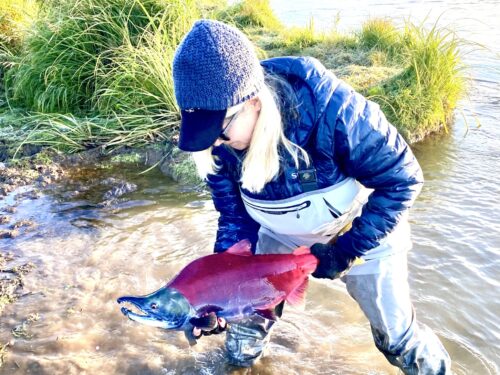
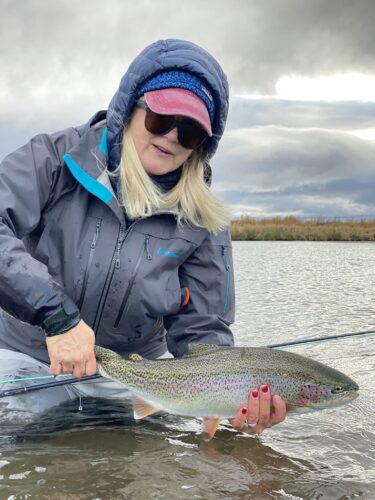
THE QUEST FOR CHAR
Sure; I wanted to swing for those Naknek migratory ’bows, but I was here for the char. On Monday evening, Kate and Justin gathered us together. Kate rattled off the options for fly-outs and wanted to schedule flights for those who wanted
to fly. She knew we wanted a ride to the Ugashik, a river running between two huge lakes out in Bristol Bay. She introduced us to our guide Ryan, who would handle the char trip. He said the Arctic char were in and the fishing had been good. The next day, with good weather, would be the time to go, so we decided to get after our bucket-list fish on day one.
Tuesday dawned cold because the night sky had been filled with stars. We got to the airplane base early, and had to wait a bit for our pilot to warm up the de Havilland Beaver. A Beaver is my favorite bush plane to ride in. We’ve been in many different bush planes and they aren’t the fastest, but they are powerful, sturdy machines.
We had an hour-long flight, and at 1,200 feet we crossed the tundra with its many small streams and potholes, then out over the ocean to where we started to pick up the mountain ranges that run down the Aleutian chain. The Ugashik is bordered by a few volcanoes, and as we swung down to the lake to land, they rose up out of the sea like the gates of a fortress – huge, snow-covered flattops seemingly reaching to the fluffy clouds hovering above.
Once down and out of the plane, Ryan surveyed the situation. There was another group of fishermen who’d arrived minutes before us and we had to assess where they were setting up. We had a long, open run to ourselves and hiked up about a quarter-mile to the top of the run to get started. The water was gin-clear, and right away Linds and I knew how we’d be fishing.
The river bottom was covered with red salmon. Sockeye still in good spawning shape had ascended the river, and we knew the char would be on a major egg feed. So, as is traditional in many parts of Alaska, Ryan hooked us up with a bead that resembled a sockeye egg and an indicator, and we began to fish.
On my first trip to Alaska some 25 years before, I had insisted I fish my Goo Bug egg pattern for the rainbows of the Alagnak River in Bristol Bay. But after nearly mortally wounding a couple beautiful rainbows because they took the fly deep, I learned the value of using beads to save the fish.
A few casts in, my indicator dropped and I set the hook on a heavy fish. Lindsay had told me these Arctic char were hard fighters, and as line screamed off my old Hardy, I found myself stumbling over the uneven tundra, falling once but keeping the rod high and maintaining the hookup.
I told Ryan I had to get in the water, finally found a spot to step in, and chased the fish down the bank. This big fish used the stiff current to her advantage and we proceeded to have a tug of war for several minutes.
Finally, we found a soft little bay off the main flow and I managed to steer her in to where Ryan netted the big double- digit-pound char. You have to love it when 20 minutes into your quest for a certain fish species, you’ve scored.
For the first couple hours I was the hot rod, landing several nice char, including a colored-up fish that was an almost-in- full-spawning-bloom male. Lindsay was scoring some fish, and Ryan concentrated on getting her a trophy. He saw a fish tail behind some sockeye, and pointed it out. Linds made the perfect cast and the fish jetted over and ate it hard.
The water exploded and her reel hissed as the fish tore off. A few minutes into the fight Ryan announced Linds had hooked a silver. The fish was dogging her in the current, making short, fast runs away from the bank. She finally moved the fish to the net and landed a coho of probably 12 to 13 pounds. I followed up with a coho of my own, so we now had two species on our scorecards.
Ryan had seen a few fish dimple the surface and told me they were grayling. I had some dry flies on me and I spent about a half hour trying to raise one without any success.
Ryan moved us down the run to a hard, fast tailout, and as soon as we got there Lindsay set up hard on a fish that dashed off down the run. She chased him a bit and finally turned him.
As Ryan netted the fish, we could both see this was the treasure, a fully pumpkin-colored Arctic char: the fish of a lifetime.
We completed the Ugashik slam by each catching a few Dolly Varden. The wind had picked up and we were now close to where the pilot had dropped us off; however, with the stiff breeze, the lake had started to swell with whitecaps and rollers, so we had to hike the length of the river run to the upper lake to be picked up.
We had caught what we came for; our quest for big Arctic char was checked off on day one. This day was bright with sunshine and the temperature had risen into the 50s. Just a perfect first day.
We got to the top of the lake above just as our ride circled around for a landing. Lindsay and I have been fortunate enough to have many rides back to camp after a successful day of fishing. This might have been the very best ride. Two years of waiting out the pandemic to hopefully get a shot at these majestic char, and we had pulled it off.
Back at the lodge, we switched from Alaskan Amber to Manhattans to toast our guide and thank him for his hard work and diligence to make this dream come true.

BACK TO OUR THIRD day of fishing and day two on the Nak. Now, anyone who decides to swing streamers in rivers while stalking migratory rainbows also signs the waiver to expect some tough days of fishing. The day before dawned cold but sunny, and by the middle of the day, it was delightful. The temperature
was probably hovering near 50 degrees, yet run after run, cast after cast, produced just one nice rainbow for Lindsay and a couple half-hearted plucks for me. Our guide Gray is a tall, sturdy man who would be a textbook tight end on any NFL team. Gray lives to swing flies at big trout and salmon. He’s also an excellent caster.
While Linds and I are very proficient two-hand casters, we can always learn from folks who do it for a living. And as hard as we fished and grinded away for eight-plus hours, by the end of the day poor Gray was beside himself, and at dinner Wednesday night he was distraught that we hadn’t had a better day. We shrug that stuff off as just a tough day.
So on Thursday, in the pouring rain, Lindsay and I were both on the board in the first 10 minutes. Justin had radioed Gray that we were already successful – probably to cheer him up.
I reset up at the top of the run, with Linds stepping in behind me again. Once again, halfway down the run I locked up another track star, and as the Mark Shamburg click and pawl diamond-of-a-benchmade reel screamed with excitement, I again angled out of the harder current and landed another dime-bright ’bow.
Lindsay hooked up again and the fish rocketed out of the water, making greyhound leaps across the run. As she does, she deftly applied side pressure up- and downstream to gain leverage and led a dime-bright coho still covered in sea lice into the waiting net.
At the top of the run, again I had a quick grab but didn’t sink the iron. Three-quarters down the run my rod and reel exploded with a thunderous grab, and a fish well past the 36-inch size range tumbled nose to tail three times across the river, locked in his turbo and was immediately 200 feet into my backing. Two more launches into the rainy atmosphere and he was now down below the big island.
Justin brought the boat over and I hopped on the bow, sat down and cranked like hell as Justin started to push the boat downstream after the fish. This was new. Never had I chased a big ’bow
while sitting on a jet sled. I regained all the line and got the shooting head back on the reel. We saw the fish swaying, seemingly tuckered out in the flow. Justin grabbed the net. Twenty feet out, this true Naknek trophy was almost mine … I could envision the oohs and ahhs from friends of the picture soon to be snapped.
The fish found one last burst of energy and threw the hook. Now, we’ve all been through this. The immediate reaction is probably to yell and curse, but maybe after all these years I’ve matured a bit, and so I was quiet; so was Justin, other than the “ahh, so close, you did a great job” routine.
Justin dragged the boat back up to its anchor, with me standing in the front of the boat like George Washington crossing the Delaware. We had gone around the bend, so Linds didn’t see the escape. She looked for confirmation, and I slowly shook my head and shrugged my shoulders. This fish would have sat at my personal trophy banquet table, right next to my two big char I’d caught a couple days before.
But there was no time for hurt feelings, and as determined as ever, I marched back up to the top of the run against the rushing current. Two casts in another shoulder-shuddering take and I was right back to watching the fly line and backing melt off my reel. But I had a better angle on this fish and, after a solid fight, led her into the waiting net. This fish, while not as big as the escapee, was a splendid specimen of pure silver and muscle.
The rain had changed to big flakes of snow. The wind was calm, so the fluffy snow gently fell on our shoulders as Justin and I sat in the boat. Only a couple hours in, I had landed three big ’bows and played a mid-30s-inch fish of a lifetime. Linds had a couple great fish in the net as well. Justin is maybe the calmest, kindest, most encouraging guide we’ve ever had the pleasure to fish with. He is also constantly trying to learn.
So he and I jumped into the state of steelhead in the U.S. He was extremely interested in what was happening with steelhead in the Great Lakes, as he has watched the West Coast fishery collapse. Meanwhile, Linds kept fishing as we dove deep into steelhead in a full-out winter wonderland. It was the kind of gentle, pretty snowfall where you’d expect to hear Christmas carols in the background.
Linds completed the drop and Justin offered that since we were so close to their lodge and marina, how about going back there, drying out, building a fire in the wood stove and having a late lunch? Linds climbed aboard and we raced back to the lodge. Justin put a fire in the stove and we sat down at a table with hot soup and sandwiches and continued our discussion about steelhead fishing in the U.S. Justin offered to throw our gloves and hats into the dryer since they’d been damp for hours.
We sat back and enjoyed the conversation and the warm fire. Lindsay and I are all about a quality experience in a day of fishing, never quantity anymore. We had both landed enough fish to make our day a success. The snow kept gaining strength and she and I unanimously decided to end the day on this warm, cozy note. Justin gave us a lift back to the King Salmon Lodge, where we had long hot showers and a relaxing last part of the day before dinner.
OUR LAST DAY WAS a plane ride to American Creek. The target was leopard spotted rainbows and char. On this day we finally got to fish with Justin’s better half, Kate. Kate was again rocking the Crump style – a kind, gentle, nurturing persona. What was different about this plane ride is that after we landed at the mouth of the creek, the pilot used the plane as a jet sled to run up the stream for what seemed like a half- mile to the boats waiting on shore.
The creek was busy that day, with more planes, guides and sports arriving, filling their boats and roaring off to find spots to fish. First stop: Lindsay waded upstream and down- and started swinging streamers. Once again, a few casts in I got the pull and was into a nice fish. Turning to get approval from my lovely wife, she was busy with her own player. Almost to the net my ’bow bid me farewell and Linds landed a beautiful leopard. That’s kind of how the day went. I got a few but dropped more, while Lindsay kept Kate busy with the net. It was also cold with angry gray skies and a stiff breeze up from the sea, so Kate built a fire and we embraced its warmth, again with hot soup and sandwiches.
I did cross off another box, landing a Dolly Varden on a streamer. To that point, I’d spent 25 years catching Dollies only on beads. Lindsay locked another player on the swing and Kate had a big smile on her face (maybe secretly cheering on the girl power that day). She yelled out, “Lindsay, you are one fishy lady.” I had to laugh, ’cause she was spot on.
ON CHANGE-OUT DAY, WE packed up, ate a hearty breakfast and sipped some coffee. Kate arrived to take us to the airport and we planned to leave early enough so we could stop by the local tavern for one last Alaskan Amber and a hot lunch.
We climbed aboard the aircraft and jetted out of King Salmon on a sunny afternoon, with the mountains shimmering in snow.
It took two years to seal the deal on this adventure, and it was worth every minute of the wait. Till next time, Alaska. ASJ
Editor’s note: Order Fishing Adventures on the Fly Techniques and Tactics, by Dave Agness at amazon.com.
Sidebar: Q&A WITH AUTHOR DAVE AGNESS
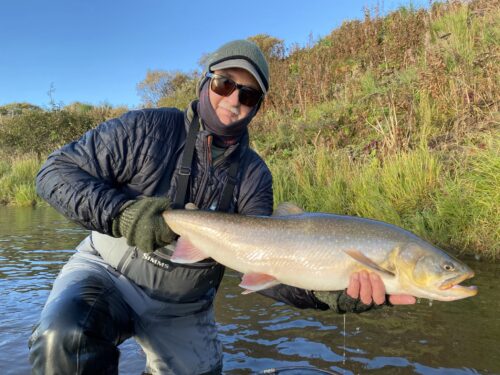
ASJ editor Chris Cocoles caught up with Dave Agness, the author of Fishing Adventures on the Fly Techniques and Tactics, to talk about some of his Alaska adventures, some favorite worldwide destinations and how he and his wife Lindsay try to give back to the sport of fishing. (This interview has been edited for clarity.)
Chris Cocoles The chapter in your book on Alaska says you and your wife Lindsay have been regular visitors to the Last Frontier. Tell us about this particular trip and how it came about.
Dave Agness My first book was published in 2019 and we were going to get back to Alaska in 2020, and, of course, Covid hit. So that threw a monkey wrench in all kinds of things and we didn’t get out to the Naknek and Bristol Bay until 2021.
CC Has Alaska been the same epic experiences for you as for so many other people I’ve encountered?
DA We consider it our second home. If we didn’t have four daughters and six grandkids all living in the same city year-round, it would be hard to not spend some more time there. But we have a pretty close-knit family and that is anchored here in Rochester [New York].
CC What was your first Alaska experience like?
DA I was a charter boat captain – part time – and I had a 43-year career at the Eastman-Kodak Company. I was writing for magazines and was the editor of a New York outdoors magazine for seven years. And I had read and written about fly fishing and fishing in general around the world. But Alaska had always piqued my interest. My dad was stationed in Alaska when he was in the service, and he had so many great stories about that.
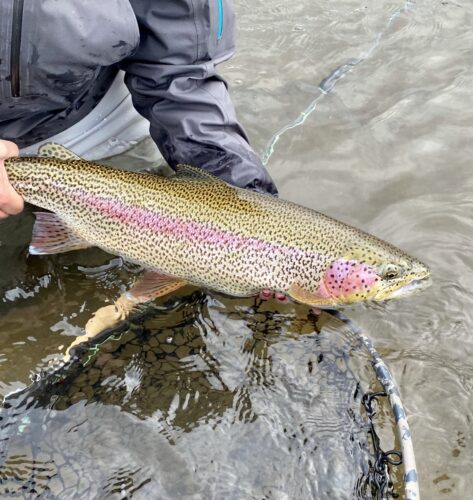
My first trip [1998] was out to the Alagnak River and Bristol Bay. When I got there at the airport in King Salmon, back then the airport was about as big as my living room. There was myself and a bunch of other guys who had gone moose hunting and they had their moose racks taped to their duffle bags to ship them back home. A guy came by, looked at me and asked, “Is this your first time?” I said, “Yeah.” And he said, “No one ever comes to Alaska once.” And he was right, because we’ve been a dozen times. Friends ask me about where to take a trip, and we’ve literally fished around the world, and sure, they can go to the Montanas, the Wyomings and the Utahs, and they’re wonderful trips. But if you want to go to a place like no other in North America, and maybe on the planet, you have to go to Alaska.
CC In reading your Alaska chapter, it seemed to me like catching those colorful pumpkin char made for a special moment for you. Was that indeed a fish of a lifetime?
DA Oh yeah. We love char. We chase steelhead here in the Great Lakes and we spend a lot of time swinging two-handed rods, and a lot of our fishing here is with spey rods catching steelhead on swung streamers. So we knew we were going to do that in Alaska. But the one fish that we went there for was the Arctic char. That was our bucket-list fish.
I had caught some Arctic char in the Alagnak that were maybe 4 or 5 pounds – small ones. But I’d never caught a big Arctic char. The pumpkin char were just exquisite, including Lindsay’s [bright-orange fish]. And we caught several that were almost that color. And the thing people don’t realize is that when you get into a fish like an Arctic char, they’re tremendous fighters. They’ll scream line off just like a salmon. And while they won’t do much jumping, they get into the current and use their girth to put a lot of pressure on your rod. They were really a great adversary on a fly rod.
CC Having savored your time in Bristol Bay, is it easy to understand how dedicated the locals and others are to protecting that region from the Pebble Mine?
DA Totally. We signed every petition out there that we can sign to keep mining away from that area. I’m deeply involved in conservation, so we’ve always been against any kind of mining in [Bristol Bay]. Kate and Justin [Crump, lodge owners who hosted the Agnesses in Bristol Bay] are on several different committees up in that area to fight the mine and get petitions signed.
CC How did you become such a fly fishing/outdoors fanatic in your western New York roots?
DA I came the route as how many guys and gals [got into fishing]. My grandfather and my father were tremendous fishermen and hunters. I shot my first clay pigeons at 8 years old. And I’ve been fishing since I can remember. And we were mostly panfishing and bass fishing. I was born in the 1950s and it wasn’t until the 1960s when Dr. [Howard] Tanner started putting trout and Pacific salmon in the Great Lakes. When that program got started my dad and I were some of the first anglers to start trolling for Pacific salmon in Lake Ontario, and I fell in love with that. By the age of 24, I had my United States Coast Guard guiding license and charter boat.
When my grandfather passed away when I was 13 years old, my grandfather gave me a fly rod –a bamboo rod and a reel. It was probably one of those Ted Williams rods that were made by the thousands. So I taught myself how to fly fish. My dad wasn’t a fly fisherman and I didn’t know that my grandfather was. And, of course, now it’s exploded all over the world.
CC Is there a part of Alaska you haven’t been to and want to get to?
DA I’ve never fished in Southeast Alaska and want to go there and get in on the coho run. So there are some places there I’d like to try. And I’ve got to be honest with you: The cost of these trips now has gotten crazy.
CC And speaking of the cost of fishing trips around the world, do you and Lindsay have another bucket-list destination on your radar?
DA I would love to go to Norway for salmon there. I’ve always been interested in New Zealand or Australia for trout fishing there. But I wouldn’t mind going back to Belize [for tarpon]. And I want to go to Baja. So that’s the next place.
CC Has it been great to be able to experience all this outstanding fishing with Lindsay?
DA Lindsay and I worked at Eastman- Kodak together. The first project we ever worked on together, she came down to my office and I wasn’t there at the time. And in my office I had tons of pictures from my charter boat fishing, as well as fly fishing pictures. One morning I came back to work and she was sitting in my office. I said, “Hey; what’s going on?” She mentioned she had seen all the fishing pictures and said, “I see that you fly fish.” And she didn’t say, “I want you to teach me to fly fish.” “You’re gonna teach me how to fly fish.” And she’s got a picture of a halibut that she caught when she was 20 years old that she got in Sitka, Alaska. She had a friend in Sitka and he had a sea kayak. He gave her a jigging rod, jumped in the sea kayak and paddled out into the Gulf of Alaska, jigged up a 40-pound halibut, paddled back to the harbor and then fed the whole dock.
I started teaching her how to fly fish and I’ve got to say, I’ve taught dozens of people how to do it, and no one’s ever learned how to fly fish faster than she did. And she’s currently a fly fishing guide. She loves to travel and she fishes like the dickens and outfishes most of the guys. There’s a story in the book about how she’s a “pickpocket.” If you put her ahead of you when going down a river, she’ll catch fish. And if you put her behind you, she’ll make you look stupid and catch fish behind you. We’ve been together for 18 years and it seems like we’ve been fishing every minute of that. When we’re not with our families, we’re fishing.
CC You also try to give back through your fishing. What has that meant to you?
DA We guide for Project Healing Waters and also for Casting for Recovery for women who have breast cancer. Lindsay’s first guiding job was with a soldier who had been wounded and was medically retired from the service. And his wife was in the service too. We became good friends and Lindsay got to teach his wife how to fly fish. She did four or five tours in Afghanistan and Iraq. She wanted Lindsay to take her steelhead fishing before her deployment and she caught a beautiful steelhead. She wanted a picture of her steelhead and one of her kids in her locker in Afghanistan. Lindsay developed a fly that’s red, white and blue, and it’s also got purple in it for a Purple Heart, and named it after her.
And then a few years later for Casting for Recovery, she designed a fly that’s black and pink, and we started catching all these steelhead with it, so I told Lindsay, “You have to name this fly.” She said, “I don’t know what to name it.” So we had a contest on Facebook with the picture of the fly and had everyone send in a name and pick one. We got like 200 entries, with one calling it Lady Hope. We’ve been so fortunate and we’ve been able to volunteer our time and help.-ASJ

